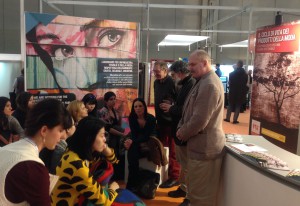
[slideshow id=1]
Sustainable fashion needs environmentally friendly designed fabrics and trimmings made with social responsibility. It is time to put one’s efforts and money where one’s mouth was.
3CCompany, Astarte, Berbrand, Besani, Bottonificio Padano, CadicaGroup, Canepa, Cotonificio Albini, Ditta G. Lanfranchi, Gruppo Dondi, Kuraray, Lanificio Zignone, Miroglio Textile, Prym Fashion Italia, Teseo Tessitura Serica di Olmeda, Tessitura Attilio Imperiali, Tessitura Monti, Vitale Barberis Canonico, Zip GFT are Italian companies ready to demonstrate it. Their records and activity are mentioned in the Sustainable Fabrics and Accessories Catalogue prepared by Blumine/sustainability-lab for the Milano Unica SS 2015 event held in February 2014. This is the third time for a growing initiative that gathers number of accessions and a great interest.
In the accessories area a dedicated exhibiting space turned into a conference area, where groups of students from universities and trade schools were given the opportunity to exchange and receive information.
A Company Review Framework that Recalls the Life Cycle Assessment Model

Let’s go back to the companies, nineteen at all, a few more than in the previous event. The list includes some top firms on the international market, a witness of Italian excellence in the fabrics and accessories segment. Promoters are keen at pointing out that the catalogue isn’t just a marketing initiative: «The companies listed in the catalogue – Blumine president Aurora Magni states – were validated on 18 benchmarks we drew up in a summary of actions aimed at improving a product life cycle and at making firms socially responsible. The benchmarks were shown in a Life Cycle Assessment designed for B2B companies, resulting in a transparent communication meant to highlight business strategies on sustainability, while giving said companies the opportunity to assess their approach as against their competitors. An exercise that generates best practices». Going through the list in the catalogue we realize that an important role was assigned to selecting raw materials which could make the most of a product if derived from a renewable, organic source or made of recycled materials. There are quotations from certifications such as GOTS for organic cotton or linen. Some companies mention biopolymers among selected raw materials, while PET man made items and raw materials that do not let animals suffer generate interest. Some business strategies show significant investment being made to cut energy and water usage as well as to track a product making operations so as to obtain a transparent and documented product description. No doubt, we are confronted with companies that are aware of the Reach regulation and of the standards and documentation language, while being socially committed to initiatives that involve their territory as well as poor communities in the world. In fact, the catalogue shows a picture of a multi-faceted sustainability and how businesses commit to implement it.
Will All That Be Sufficient to Let the ‘Made in Italy’ Regain its Competitive Power?
The time seems very far when for a fabric to be fashionable it had to inevitably make use of aggressive chemicals causing harmful emissions and water usage, while, on the contrary, environmentally friendly fabrics had to give up creativity and style. Nowadays, sustainability goes hands in hands with creative ambitions and colour and material originality, making use of green chemicals and recent a technology to exploit recent research and obtain excellent results while reducing CO2. Sustainable fabrics and accessories exhibited at Milano Unica demonstrate how beauty and environment protection can skilfully blend; it is encouraging to see how this philosophy is taking more and more hold at each event. In fact, it is a widely held view that being eco-friendly makes you even more interesting to buyers and brands committed to meet the increasing requirement of sustainability from consumers and environmental movements. Hence, more competitive.
Greenpeace leaders attending Milano Unica are not a casual signal.
Tony Sadownichik, head of Detox, the initiative launched by Greenpeace in 2011 to apply for interventions of fashion brands to remove number of polluting chemicals, has paid great attention to Italian manufacturers of semifinished goods. Sadownichik met with students from the IED International course in the Blumine sustainability area, while visiting some booths of exhibitors listed in the Catalogue; he also held a short welcome speech at the conference organised by Canepa, a weaving mill from the Como area that committed on Detox. In other words, the meeting with environmental movement activists and trade professionals could give way to a more environment friendly and sound fashion caring for natural resources and consumers’ health.
The growing sentiment of sustainability was acknowledged in a statement by Silvio Albini, Milano Unica President, at the opening ceremony of the exhibition and in an interview granted to the press.
We may expect improving activities at Milano Unica devoted to spread a more sustainable and environment friendly fashion.



